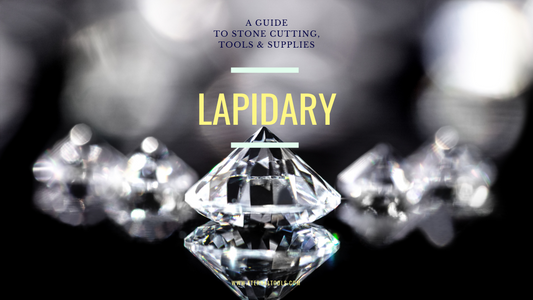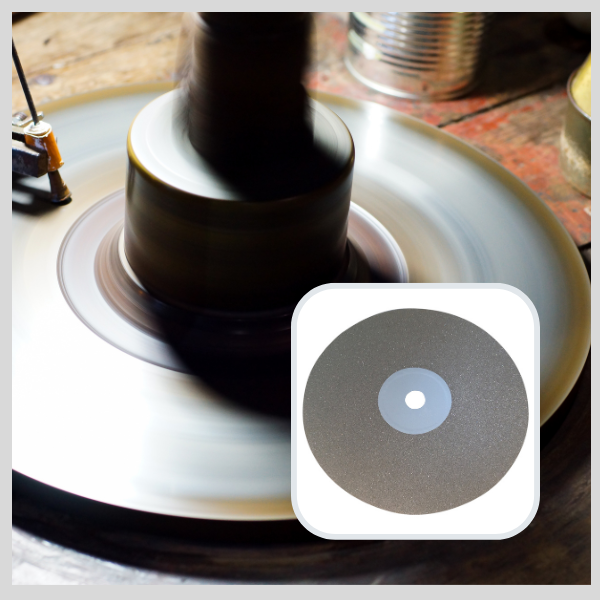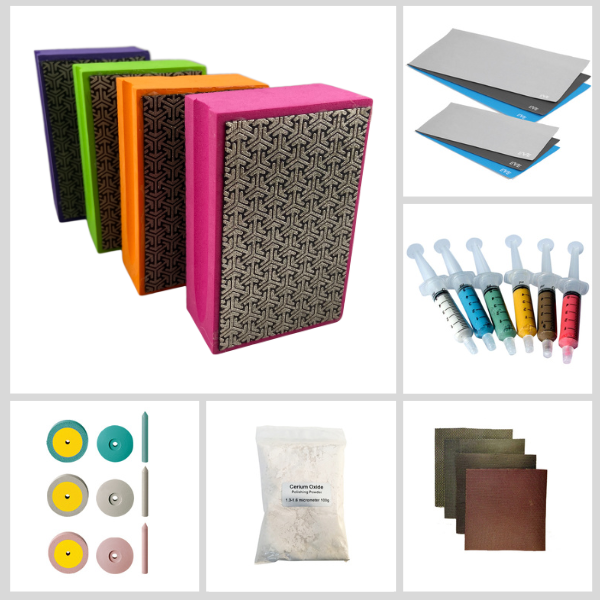Lapidary arts is an ancient art form that involves cutting, shaping, and polishing gemstones and minerals to create beautiful and intricate works of art.
The term lapidary comes from the Latin word "lapis," which means stone.
The art of lapidary has been practiced for thousands of years, and it has been used to create everything from jewellery to sculptures.
In this article, we will explore the history of lapidary, the lapidary materials required and techniques used in lapidary, and the different types of lapidary projects that you can undertake.
Brief History of Lapidary
The art of lapidary can be traced back to ancient civilisations such as the Egyptians, Greeks, and Romans. These civilisations used lapidary techniques to create jewellery, decorative objects, and even weapons.
In ancient Egypt, lapidary was a highly respected art form, and lapidaries were considered skilled craftsmen. They created intricate pieces of jewellery for the pharaohs and other members of the royal family.
During the Middle Ages, lapidary continued to be an important art form, especially in Europe. Many of the precious stones that were used in medieval jewellery were cut and polished by lapidaries. Lapidary techniques were also used to create decorative objects such as chalices and reliquaries.
In the 16th and 17th centuries, lapidary techniques became more advanced, and lapidaries began to experiment with new cutting and polishing techniques. This led to the creation of more intricate and detailed jewellery pieces, and lapidary became even more popular.
Lapidary Techniques
In addition to these tools, lapidaries also use a variety of techniques to create their works of art. Some of the most common techniques include:
- Cabochon cutting
- Polishing
- Faceting
- Carving
Each technique requires a different set of skills and tools. Here's a brief overview of each technique:
Faceting
A facet is a flat, polished surface on a gemstone that is created through the process of faceting. Faceting involves cutting and shaping a rough gemstone into a multi-faceted, polished gemstone.
Different cuts of facets can create unique patterns of light reflection and refraction, resulting in a range of stunning visual effects. The science behind faceted gemstones is complex, as it involves understanding how light interacts with different cuts and shapes.
Faceting is done using a faceting machine, which has a spinning wheel with diamond-coated discs. The lapidary will use the machine to cut precise facets into the stone, creating a beautiful, sparkling effect.
Cutting
Cutting is the process of separating a rough gemstone or mineral into smaller pieces. This is usually done with a saw, which can be either a diamond saw or a blade saw. Diamond saws are used for harder materials, while blade saws are used for softer materials.
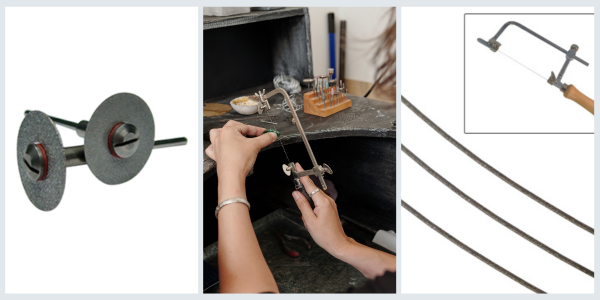
Polishing
Polishing is the process of smoothing and shining a gemstone or mineral. This is done using a series of abrasive materials, starting with a coarse grit and moving to finer grits. The final step is usually a polishing compound, which gives the stone a high shine.
Shaping
Shaping is the process of creating a specific shape or design in a gemstone or mineral. This is usually done using a grinding wheel or a sanding disc. The lapidary will use these tools to shape the stone into the desired shape, whether it's a round cabochon or a faceted gemstone.
Carving
Carving is the process of creating a three-dimensional design in a gemstone or mineral. This is usually done using a rotary tool, which has a variety of bits and attachments that can be used to carve or engrave intricate designs.
Lapidary Equipment: Tools and Supplies
Lapidary requires a variety of tools and techniques to cut, shape, and polish gemstones and minerals. In order to manipulate natural stones, precious, semiprecious stones or even synthetic gems you will need to use a material that is harder than the gem itself.
Therefore, all Lapidary tools will be made from diamond - the hardest material.
Some of the most common tools used in lapidary include:
Saws
The art of cutting requires the use of Saws. These are used to cut rough stones and lapidary slabs into smaller pieces that can be shaped and polished.
There are many different types of saws used in lapidary, including diamond blades and diamond saws, which use diamond-coated cutting blades to cut through hard materials either in a slab saw or jewellers piercing saw frame for smaller gemstones.
Grinders
Grinders are used to shape and polish gemstones and minerals and remove rough spots. They come in a variety of shapes and sizes, and they can be used to create a variety of shapes and textures.
- Diamond Burrs
- Diamond Files
- Diamond Grinding Pads
- Diamond Hones
- Diamond Wheels
- Diamond Flat Laps
- Diamond Sheet
Polishers
Polishers are used to give stones a smooth, shiny finish. They use a variety of polishing compounds and materials, such as diamond paste, powder, hand pads, cerium oxide, and diamond rotary tool polishers to achieve a high level of shine.
- Diamond Cloth
- Diamond Sheet
- Cerium Oxide
- Diamond Lapping Paste
- Aluminium Oxide Powder: Diamantine
- Diamond Hand Pads
- Diamond Rotary Tool Polishers
Rotary Tools
Rotary tools are used for carving, shaping and engraving gemstones and minerals. They have a variety of bits and attachments that can be used to create intricate designs.
Diamond rotary burrs are mostly used, but also silicon carbide, aluminium oxide burrs (corundum) and white Arkansas stone burrs as well.
Certain diamond burrs can be used to create a specific shape from the gemstone, for instance, a Diamond Donut Burr is used for creating a disc with a hole for the use of pendants, and a bead shaping diamond burr will round off your stone into a bead shape. A diamond wheel burr and other larger-sized burrs are more suited for sculptural stonework.
Take a look at our whole range of Diamond Burrs.
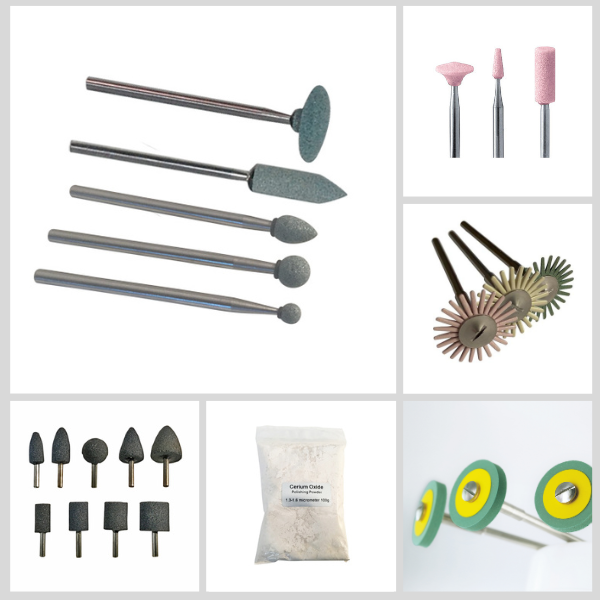
Drills
Diamond drills are used for creating holes in gemstones for the purpose of threading cord or jewellery thread through, or for fixing through a bail or fixing.
Lapidary Wheels And Belts
Lapidary wheels are used to shape and polish stones. They come in a variety of shapes and sizes, and they can be used to create a variety of shapes and textures.
A lapidary flat wheel can be used on a flatbed grinder whereby you would take your gem materials to the lap, and grind until you have achieved the desired facet or shape.
Diamond wheels and diamond belts can be fitted to lapidary machines or faceting machines.
Faceting Machines
Faceting machines are used to cut precise facets into gemstones. They have a spinning wheel with diamond-coated discs often referred to as a Flat Lap that are used to cut the facets.
Tumblers
Tumblers are used to polish gemstones and minerals in large quantities. They work by tumbling stones with abrasive materials, such as sand or grit, to create a smooth, polished finish.
Types Of Gemstones And Minerals
Some of the most popular materials used in lapidary include:
Quartz
Quartz is a popular material for lapidary because it is relatively easy to work with and comes in various colours and patterns. As it is particularly hard to manipulate, any grinding, cutting and shaping can be done using Vacuum Brazed diamond burrs.
Agate
Agate is a type of chalcedony that is often used in lapidary. It comes in various colours and patterns and is often used to create cabochons and beads.
Jade
Jade is a hard, durable material that is often used in lapidary. It comes in a variety of colours, from white to green to black. Have a read of our article The Complete Guide To Jade Carving.
Opal
Opal is a beautiful, iridescent gemstone that is often used in lapidary. It is a delicate material that requires careful handling.
Popular Lapidary Projects And Applications
Lapidary can be used for a variety of projects and applications, from jewellery making to sculpture to home decor. Here are some popular lapidary projects:
Jewellery Making
Lapidary is often used in jewellery making to create beautiful, one-of-a-kind pieces. Gemstones and minerals can be cut and polished into cabochons, faceted gemstones, and beads. Take a look at the work of Charlotte De Syllas, some of which can be seen below. Her inspiring work is much sought after, and for good reason.
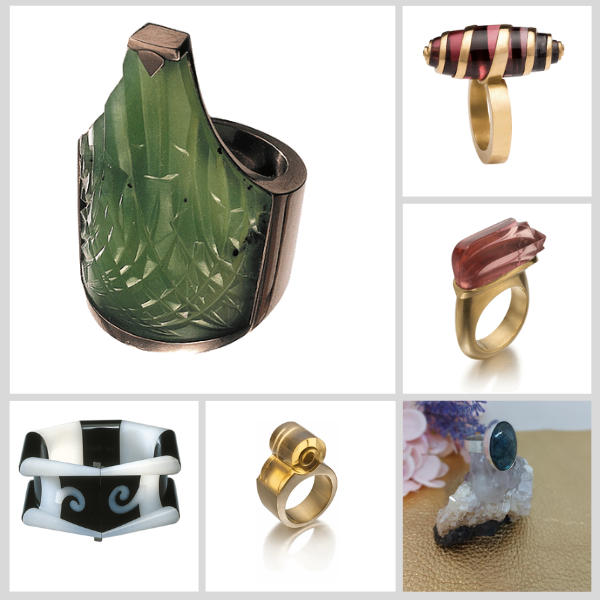
Sculpture
Lapidary can also be used to create sculptures and other three-dimensional art pieces. Gemstones and minerals can be carved into intricate designs, creating stunning works of art.
Home Decor
Lapidary can be used to create various home decor items, such as bookends, coasters, and vases. Gemstones and minerals can be shaped and polished into beautiful, functional pieces.
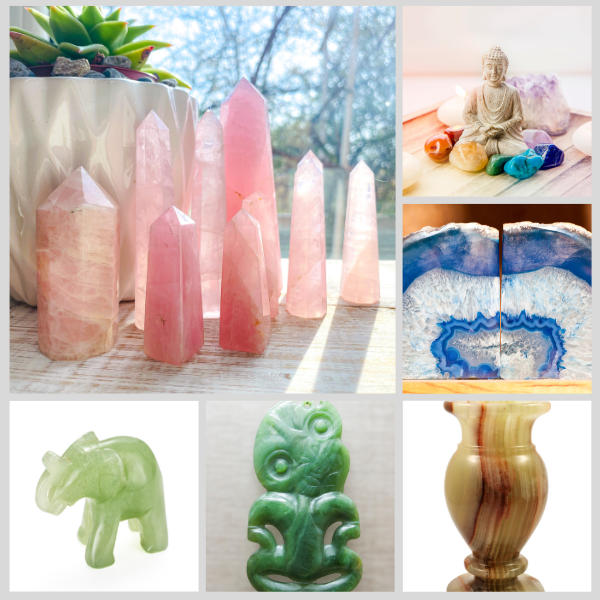
Lapidary Today
Today, lapidary is still a popular art form, and it is practised all over the world. There are many lapidary clubs and organisations that promote the art of lapidary and provide resources and support to lapidaries.
Lapidary is a fascinating process that allows us to appreciate the natural beauty of gemstones and minerals. It is a process that has been around for thousands of years, and it continues to be relevant in the contemporary world.
Rock Hounds, beginners and experienced lapidarists will always find something new to learn and explore. So why not give it a try and see where your creativity takes you?
Further articles that may be of interest to you: The Art and Science of Fossil Preparation: Tools Guide, and 7 Hand Polishers That Will Produce A Mirror Finish in Under 10 Minutes.

